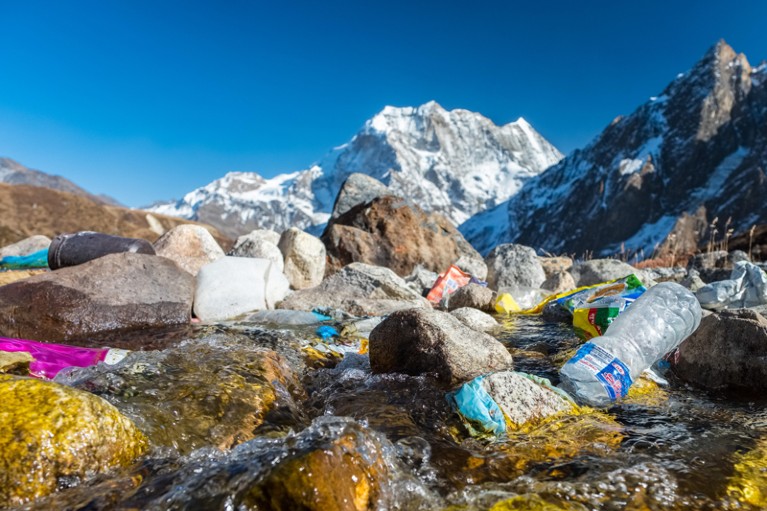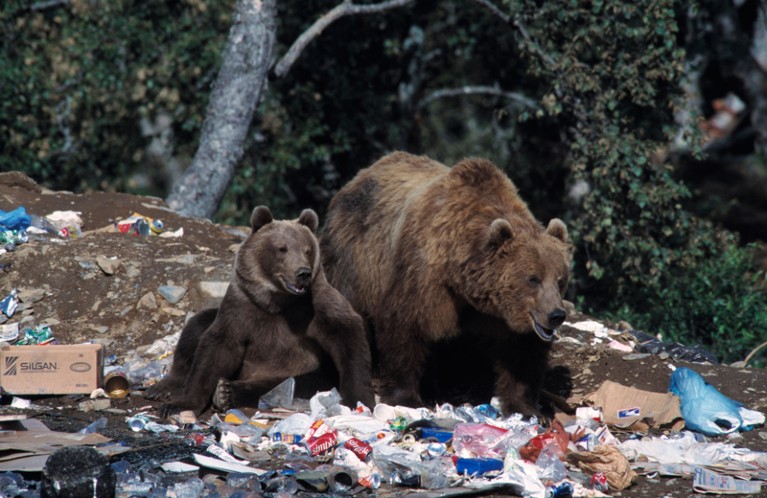In June, more than 2,000 volunteers participated in the 2024 Global Ocean Cleanup campaign and netted nearly 40 tonnes of plastic debris from just some 80 kilometres of ocean and coasts across the world, including sites from Vietnam to California. Although representing one week’s hard work for the volunteers, such initiatives are a drop in the ocean of plastic waste that is generated each year — about 400 million tonnes, equivalent to the weight of all adult humans currently on Earth.
A plethora of projects and policies, both national and international, aim to tackle plastic pollution. In 2019, for example, the Association of Southeast Asian Nations set up a Framework of Action to reduce marine debris. The European Plastics Pact, in place since 2021, brings 15 governments and 82 private businesses together to reduce, reuse and recycle plastics as much as possible. And the legally binding UN Global Plastics Treaty, currently under discussion through the Intergovernmental Negotiating Committee on Plastic Pollution, should be finalized by the end of the year.
Yet one aspect is often overlooked: the communities of microbes hosted by plastic debris, which form the ‘plastisphere’1,2. Initial studies suggest that this human-made habitat serves as a widespread, mobile reservoir of various microbial hazards such as pathogens3–5 — yet little else is known.
As scientists working on the environmental and health implications of plastic pollution, we urge both the public and private sectors to map plastisphere microbiomes, to understand how they interact with existing ecosystems, assess the risk they pose to humans and ecosystems, and develop mitigation strategies.
What we know
The ubiquity of plastic waste means that the plastisphere covers vast expanses of water and land. More than 7 billion tonnes of plastic waste have been generated globally so far, about 80% of which has accumulated in the environment.
As even more plastic waste is generated and degrades extremely slowly, the plastisphere is expanding rapidly — an ideal place for colonization by microorganisms, which tend to attach to a surface. More than 80,000 diatoms were found in one square centimetre of the marine plastisphere6. One gram of marine plastic can harbour ten times the microbial biomass of a cubic metre of open ocean water7.
Plastics consist of, and take up, a variety of compounds that can serve as nutrients for microbes, which in turn can affect the biogeochemical cycling processes on land and in water. Microbes of the plastisphere can be an important part of the carbon and nitrogen cycles3,8,9, for example, and might drive the production of greenhouse gases, including carbon dioxide, methane and nitrous oxide.

Even remote regions such as the Himalayas contain plastic pollution.Credit: Alamy
And the plastisphere hosts a variety of pathogens, including viruses and antibiotic-resistant bacteria that affect the health of plants, animals and humans3,4,10,11. Many of these microbes are not detected in the surrounding media3. Vibrio bacteria, for example, which are normally rare in the open ocean, are widely distributed in plastispheres throughout the mid-North Atlantic Ocean1,5, where they can cause diseases in marine life, including fish, shellfish and corals, as well as in humans. Genes that can render microorganisms resistant to antibiotics are also more common in the plastisphere than in surrounding areas4,5. Within it, viruses survive longer and are more infectious10. Harmful algae such as Pseudo-nitzschia, known for producing the neurotoxin domoic acid that causes amnesic shellfish poisoning, have also been shown to thrive in the plastisphere6.
The fact that the plastisphere is composed of plastic fragments ranging in size from micrometres to several metres means that it can carry inhabiting microbiomes that enter ecosystems and the food chain in many ways. Crops such as wheat and lettuce, for example, can directly absorb submicrometre-sized plastic particles and transport them from roots to shoots12. Plastic particles with sizes larger than tens of micrometres have been found in a range of human tissues, such as the carotid artery, lung and colon tissue, and in faeces13,14. Larger fragments, around a few centimetres long, can easily be ingested by animals such as fish, turtles, birds and terrestrial herbivores.
Finally, plastic particles and their microbial residents often travel long distances, either through trade routes or in the form of waste carried by streams, rivers and wind, for example, and can skew the natural distribution of microbial species. This can accelerate the spread of pathogens and antimicrobial resistance, disturb ecosystems and prompt disease outbreaks.
Quantify effects
Metrics are needed to quantify the influence that plastisphere microbiomes have on ecosystems and their populations, and to forecast the potential risks.
Researchers should collaborate across disciplines to combine findings from monitoring efforts on the ground, from laboratory experiments and from models that simulate the transport of plastic materials.
It is crucial to harmonize sampling procedures, experimental methodologies and instrumentation to characterize the complex genetic, microbial and metabolic landscapes of the plastisphere. Some existing projects and organizations, such as the Global Microplastics Initiative (run by Adventure Scientists in Bozeman, Montana); the Ocean Cleanup in Rotterdam, the Netherlands; the 5 Gyres Institute in Santa Monica, California; and the UN Global Estuaries Monitoring Programme, should establish standards and protocols on local, regional and global scales. Sharing samples and data would help. During clean-up activities, for example, plastic samples and contamination data should be collected and shared according to standardized procedures.

Plastics carry microorganisms that can harm animals, such as Kodiak bears in Alaska. Credit: Martin Almqvist/Alamy
Researchers should aim to accurately map the location and abundance of pathogens, antibiotic-resistant microbes and genes associated with plastispheres, and quantify their influence on climate change through the emission of greenhouse gases, for example.
It is also important to map the trajectory, transport dynamics and fate of plastic debris carrying microbiomes across ecosystems, regions and countries, such as from landfills to rivers and oceans, and from waste-exporting countries to waste-importing ones. Studying where microorganisms, especially pathogens, come from by analysing genetic elements or environmental factors can be useful. And modelling can help to track the ecological perturbations resulting from the increasing concentration, and transport, of plastispheres in ecosystems.
Redefine plastic pollution
Currently, risk assessments associated with plastic pollution mostly involve effects arising from the physical and chemical aspects of plastics — their size, shape, polymer type and additives. Turtles and seals get entangled in large debris; smaller fragments can block the digestive systems of fish or seabirds. Harmful compounds such as bisphenol A and phthalates also leach out of plastics.
Now, the microbial risks they pose must be considered, too. We propose four priorities for risk assessments.
Identify hotspots. Locations such as farms, urban rivers and coastal areas are key sources and sinks of plastic waste, and have intensive interactions with humans and food-safety concerns.
Protect vulnerable sites. Aquaculture zones, wild fisheries, nature reserves, wildlife sanctuaries, coral reefs and wetlands have crucial roles in maintaining biodiversity, regulating climate factors and providing food. They are also highly sensitive to pollution and microbial invasion.
Target transport. Regions and entities where plastics transit and accumulate — such as estuaries, harbours, wastewater treatment plants and vessels engaged in long-range transport — also need targeted risk assessments.
Focus on the food chain. Microplastics build up in foods ranging from leafy vegetables to seafood, directly threatening human health.
Sustain funding
Organizations such as the United Nations Environment Programme (UNEP), the Global Environment Facility in Washington DC, the Belmont Forum in Montevideo, Uruguay, and the World Bank should initiate funding programmes to support large-scale surveillance and assessment efforts.
Studies that track the flow of plastics and assess their health risks should focus on countries in the global south. They often need better waste-treatment capacity and public health safeguards — and often have to deal with waste exports from the global north, including Germany and the United Kingdom.
Relevant research funding bodies, such as the National Natural Science Foundation of China, the US Environmental Protection Agency and Horizon Europe, should establish collaborative research actions to co-finance projects involving scientists from different geographical regions.
Establish expert panels
Science-policy bodies must act, too. The Intergovernmental Science-Policy Panel on Chemicals, Waste, and Pollution Prevention, for example, was created in 2022 under a UNEP mandate to bridge the gap between science and policymaking, and to address global issues related to chemical waste and pollution. It should have a branch that focuses specifically on plastic pollution and risks from plastispheres. Such a centralized approach might help to establish standards, support research and track outcomes that are relevant to policy.
Adjust management strategies
Environmental policymakers and regulators should prioritize plastisphere management and control for key regions that are identified as at-risk by researchers. It is crucial to mitigate the transport of microbes through global trade networks for plastic waste. Collaborations between the UNEP, the World Trade Organization, the teams involved in relevant UN Sustainable Development Goals, the Basel Convention’s Global Plastic Waste Partnership and local governments must be put in place to continue reducing trade routes. All countries must also work to diminish the production of single-use plastics and to innovate eco-friendly alternatives. Promoting a focus on the entire life cycle of plastics and shifting from a linear model (take–make–waste) to a circular economy (in which plastics are reused, repurposed, recycled, composted or biodegraded) will help significantly.
Protect people
With talks on the UN global plastics treaty under way, we urge the Intergovernmental Negotiating Committee on Plastic Pollution to comprehensively address the environmental and health risks of plastic pollution.
For populations at high risk of exposure, protective measures against pathogens and antimicrobial resistance are paramount. Environmental and health authorities should expand existing food-safety programmes — which already monitor contaminants such as heavy metals, pesticides and bacterial pathogens — to include microplastics and communicate these potential risks to consumers. For people working as waste pickers, in landfill sites and in the import and export of plastic waste, employers should provide customized protective gear, wage supplements and regular health screenings.
An international not-for-profit forum on plastic pollution should be established by scientists and expert panels to facilitate the exchange of research findings and prompt collaborations among scientists, policymakers, private stakeholders and the public. Organizations that can serve as a blueprint exist in different fields — the World Economic Forum in Cologny, Switzerland, and the Global Water Partnership in Stockholm, for example.
Finally, science communicators and the media must keep the public informed of the existing risks and any mitigation actions taken by public and private entities.
A unified global strategy is needed to tackle the microbial risks associated with the plastisphere; the UN negotiations around the plastics treaty can spur concrete action.


